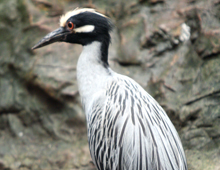Description: The Yellow-crowned night heron is a stocky wading bird with a gray body and mottled brown and white wings. Its head is black with a white streak on both sides of its face; the eyes are large and red; and the bill is thick and black. The crown is pale yellow and sweeps back as a plume. This heron has yellow legs that become pinkish-red during the breeding season. Males and females look similar, but females are generally smaller. Juveniles have grayish plumage, with buff spotting on the underside. Eyes are yellow to amber in color and legs are a yellowish-green. They generally attain adult plumage at about two years of age.
Size: Adults grow to about 21.5-27.5 inches (55-70 cm) in length, with a wingspan of 42-44 inches (106-112 cm) and weigh 1.4-1.76 pounds (0.6-0.8 kg).
Behavior: Yellow-crowned night herons are mainly nocturnal, although they sometimes search for food during the day. Prey is generally found by wading in shallow water in tidal creeks and tide pools with its bill partially submerged thrusting it forward in a scooping motion. They are territorial and defend themselves and their territory with their claws and bill.
Diet: Diet consists mainly of crustaceans, although fish, amphibians, aquatic insects, snails and small snakes are sometimes consumed as well.
Communication: The common flight call is a high, squawking bark that sounds like “kowk” or “kaow”. Males perform courtship rituals of display flights and neck- stretching.
Reproduction: Yellow-crowned night herons nest in loose colonies in dense vegetation. Nests are platforms built of a loose network of dry sticks, weeds and fibrous roots that are generally constructed in trees, but occasionally they are built on the ground. Females lay two to four pale blue-green eggs, which are incubated for 21-25 days by both parents. Both parents raise the young who fledge when they are about 25 days old.
Habitat/range: They live in mangroves and coastal areas, freshwater marshes and wooded swamps and thickets. Once considered a rather tropical bird, they have expanded their North American range in recent years to the north and west. They are also found throughout Central and South America.
Status: Listed as Least Concern on the IUCN Red List.



